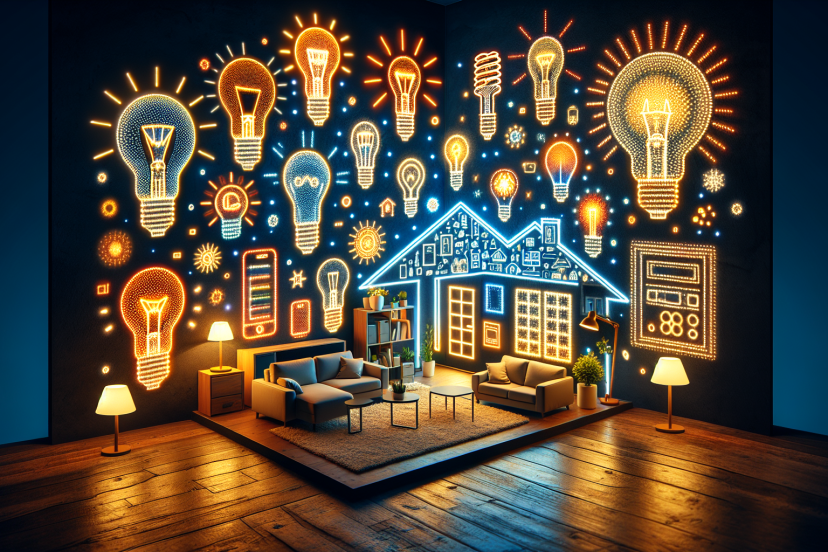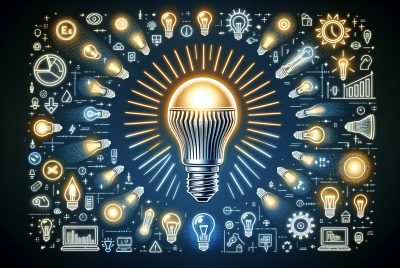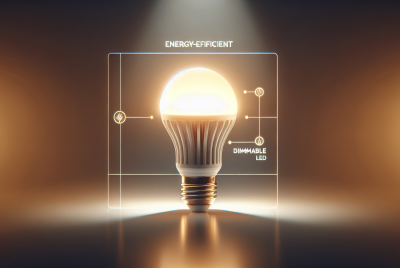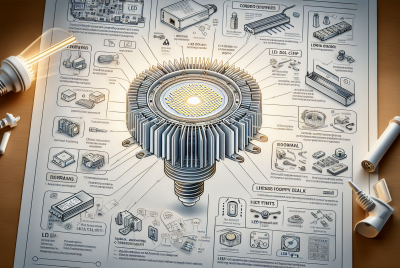Why LED Lighting Is The Future Of Home Illumination
Are you tired of constantly replacing light bulbs and dealing with high electricity bills? Look no further. LED lighting is here to stay and revolutionize the way we illuminate our homes. With its energy efficiency, long lifespan, and versatility, LED lighting has quickly become the future of home illumination. In this article, we will explore the countless benefits of LED lighting and why it is the ideal choice for any homeowner looking to create a bright and sustainable living environment. Say goodbye to outdated lighting methods and embrace the future of home illumination with LED technology.
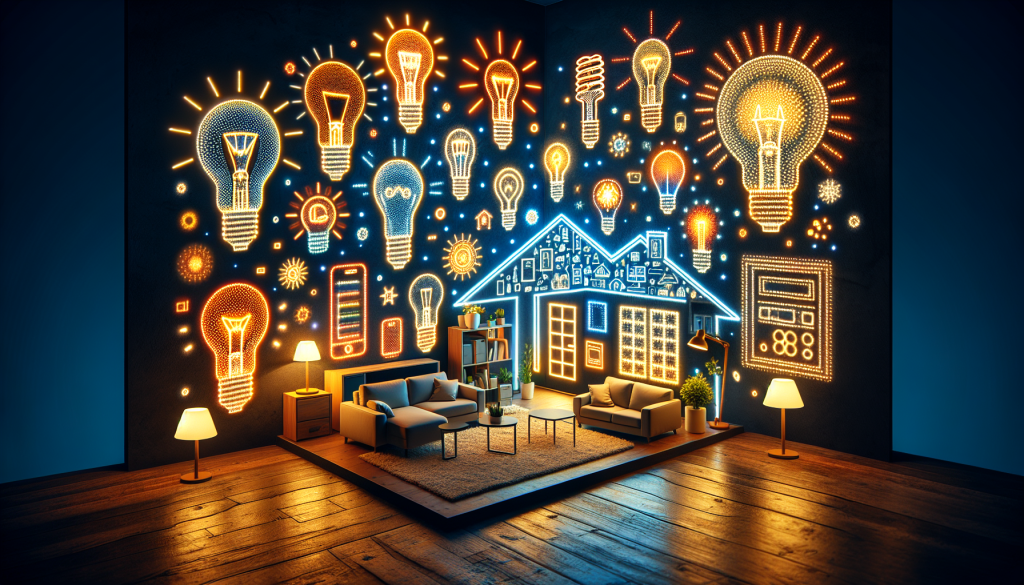
Benefits of LED Lighting
Energy Efficiency
LED lighting is a highly energy-efficient option for illuminating your home. Compared to traditional incandescent bulbs, LED lights consume significantly less electricity to produce the same amount of light. This means that by using LED lighting throughout your home, you can save a considerable amount on your energy bills while reducing your carbon footprint.
Long Lifespan
One of the major advantages of LED lighting is its exceptionally long lifespan. LED bulbs can last up to 25 times longer than traditional incandescent bulbs and up to 10 times longer than compact fluorescent lights (CFLs). This means that you won’t have to worry about frequently replacing bulbs, reducing both the hassle and the cost of maintenance.
Environmentally Friendly
LED lighting is an environmentally friendly choice. Unlike traditional light bulbs, LED lights do not contain harmful substances such as mercury. Additionally, LED lights have a lower carbon footprint due to their energy efficiency. By choosing LED lighting for your home, you are contributing to a healthier and more sustainable future for our planet.
Cost-effective
Although LED bulbs may have a higher upfront cost compared to traditional bulbs, they offer significant long-term cost savings. LED lights consume less energy and have a longer lifespan, which means you’ll spend less on replacement bulbs and lower electricity bills. Over time, the cost savings of LED lighting can outweigh the initial investment, making it a cost-effective choice in the long run.
Instant On
LED lights illuminate instantly, without the need for warm-up time like some traditional light bulbs. This means that when you switch on an LED light, it will provide full brightness immediately. The instant-on feature of LED lighting is not only convenient but also ensures that you have adequate lighting whenever you need it, without any delays.
Durability
LED lights are highly durable and resistant to shocks, vibrations, and external impacts. Unlike traditional incandescent bulbs, LED lights do not have a delicate filament that can easily break. This makes LED lighting a suitable choice for areas where frequent handling or rough conditions are expected, such as garages, workshops, or outdoor lighting applications.
LED Technology Advancements
Improved Efficiency
LED technology has witnessed significant advancements in terms of efficiency. Modern LED lights are capable of producing more lumens per watt, which means they can provide greater brightness while consuming less energy. With improved efficiency, you can achieve the same level of illumination using fewer LED lights, further enhancing your energy savings.
Color Options
LED lighting offers a wide range of color options to suit your preferences and needs. From warm white to cool white, you can select the color temperature that best matches the ambiance you desire for different areas of your home. Additionally, LED lights can produce vibrant and saturated colors, allowing for creative lighting designs and customization.
Smart Lighting
One of the remarkable advancements in LED technology is the integration of smart lighting features. LED lights can now be connected to smart home systems, allowing you to control and automate your lighting through smartphone apps or voice commands. With smart lighting, you can easily adjust the brightness, color, and even create lighting schedules to enhance your comfort and convenience.
Dimming Capabilities
LED lights offer seamless dimming capabilities, enabling you to adjust the brightness levels according to your preferences and needs. Unlike traditional incandescent bulbs, which may flicker or have limited dimming options, LED lights provide smooth and consistent dimming without compromising their performance or lifespan. This allows you to create the perfect ambiance for any occasion.
Design Flexibility with LED Lighting
Variety of Shapes and Sizes
LED lighting offers a wide variety of shapes and sizes, providing you with endless design possibilities. Whether you’re looking for recessed lights, track lights, pendant lights, or decorative fixtures, LED lights come in various form factors to suit your aesthetic preferences and complement the style of your home.
Flexible Installation Options
LED lights are versatile when it comes to installation. They can be easily integrated into existing lighting fixtures, making it a convenient option for retrofitting your home with LED lighting. Additionally, LED strips and flexible LED lights allow for creative and flexible installation options, enabling you to highlight architectural features, create accent lighting, or even add a touch of drama to any space.
Enhanced Aesthetics
LED lighting can significantly enhance the aesthetics of your home. With their small size and focused light output, LED lights can be used to highlight artwork, emphasize architectural details, or create a visually appealing atmosphere. Whether you prefer a minimalist and modern look or a warm and cozy ambiance, LED lighting offers endless possibilities to elevate the aesthetics of your living spaces.
Health and Safety Benefits of LED Lighting
Reduced Heat Emission
LED lights emit significantly less heat compared to traditional bulbs. This not only reduces the risk of accidental burns or fire hazards but also makes them more comfortable to use, especially in areas where heat-sensitive materials or proximity to people is a concern. With LED lighting, you can enjoy a safer and more comfortable lighting experience.
No UV or Infrared Emissions
Unlike traditional lighting technologies, LED lights do not emit harmful ultraviolet (UV) or infrared (IR) radiation. This is especially beneficial for areas where UV radiation can be detrimental, such as museums, art galleries, or spaces where sensitive materials or artwork are displayed. LED lighting ensures the preservation of valuable items while providing optimal illumination.
No Mercury Content
Another significant health benefit of LED lighting is that it does not contain mercury. Traditional fluorescent bulbs and compact fluorescent lights (CFLs) contain mercury, which can be hazardous if they break or are not disposed of properly. LED lights eliminate the risk of mercury exposure, making them a safe and eco-friendly choice for your home.
Flicker-free Lighting
LED lights provide flicker-free lighting, which is beneficial for both your health and comfort. Flickering lights can cause eye strain, headaches, and fatigue, especially in areas where you spend a significant amount of time, such as offices or study rooms. LED lighting ensures a steady and constant light output, promoting a more comfortable and productive environment.
Improved Sleep Quality
LED lighting with adjustable color temperature and dimming capabilities can positively impact your sleep quality. Warm white or dimmed LED lights in the evening create a relaxing and soothing atmosphere, signaling to your body that it’s time to wind down and prepare for sleep. By mimicking natural light patterns, LED lighting can contribute to a better sleep routine and overall well-being.

Cost Savings with LED Lighting
Lower Energy Bills
One of the primary reasons why LED lighting is gaining popularity is its ability to reduce energy consumption, resulting in lower energy bills. LED lights are significantly more energy-efficient than traditional bulbs, converting a higher percentage of electricity into light instead of wasted heat. By making the switch to LED lighting, you can enjoy substantial savings on your monthly energy expenses.
Reduced Maintenance Costs
Due to their long lifespan and durability, LED lights require less frequent replacement compared to traditional lighting options. This translates into reduced maintenance costs, as you won’t need to purchase and install new bulbs as frequently. Additionally, the robust construction of LED lights ensures that they can withstand the test of time, reducing the need for replacements due to breakage or damage.
Integration with Smart Home Systems
App Control
LED lighting can be seamlessly integrated with smart home systems, allowing you to control your lights through smartphone apps. With just a few taps on your phone screen, you can easily adjust the brightness, change colors, or create lighting schedules. This level of convenience puts the power of lighting control right at your fingertips.
Voice Control
LED lights compatible with voice assistants, such as Amazon Alexa or Google Assistant, enable you to control your lights using voice commands. By simply speaking your instructions, you can turn lights on or off, adjust brightness, or change colors without needing to reach for your phone or a physical switch. Voice control adds a whole new level of simplicity and hands-free convenience to your lighting experience.
Scheduling and Automation
Smart LED lighting systems allow you to schedule lighting scenes or automate their behavior. This means you can set your lights to turn on and off at specific times, create dynamic lighting patterns, or sync them with other smart devices in your home. Whether it’s simulating occupancy while you’re away or setting the perfect ambiance for movie nights, LED lighting integration with smart home systems offers endless possibilities for personalized and automated lighting control.
Environmental Impact of LED Lighting
Reduced Carbon Footprint
LED lighting plays a significant role in reducing carbon emissions. By consuming less energy and having a longer lifespan, LED lights contribute to overall energy conservation and decreased reliance on fossil fuels. When compared to traditional lighting options, LED lights can help lower your carbon footprint and contribute to a more sustainable and eco-friendly future.
Waste Reduction
With their long lifespan, LED lights greatly reduce waste generation compared to traditional bulbs. By requiring fewer replacements, LED lights help minimize the disposal of used bulbs, which may contain hazardous materials such as mercury. Additionally, the durability of LED lights results in reduced product waste, as they are less likely to break or fail prematurely.
The Future of LED Lighting
Advancements in Efficiency
The future of LED lighting holds the promise of even greater efficiency. Ongoing research and development in LED technology aim to further improve their energy efficiency, allowing for more lumens per watt. These advancements will not only enhance energy savings but also open up new possibilities for innovative lighting designs and applications.
Integration with IoT
LED lighting is becoming a key component in the Internet of Things (IoT) ecosystem. By connecting LED lights to the internet, they can communicate with other smart devices, gather data, and adapt their behavior accordingly. This integration with IoT enables intelligent lighting solutions, such as adaptive lighting for optimized energy usage or lighting that responds to environmental conditions.
Increased Adoption in Homes
As the benefits and technology of LED lighting continue to advance, more and more homeowners are embracing this lighting solution. LED lighting has become the preferred choice for new installations and retrofits due to its energy efficiency, longevity, and versatility. As awareness grows and costs continue to decline, LED lighting is well on its way to becoming the standard for residential illumination.
Potential Applications
LED lighting offers unlimited potential for various applications. From architectural and accent lighting to horticultural lighting and automotive lighting, LED technology is being utilized in diverse industries. The future of LED lighting holds the potential for further innovation and adaptation in sectors such as healthcare, transportation, and entertainment, where lighting plays a crucial role.
LED vs Traditional Lighting
Comparison of Energy Efficiency
LED lighting outperforms traditional incandescent bulbs and even other energy-efficient options such as CFLs when it comes to energy efficiency. LED lights convert a higher percentage of electricity into light, reducing wasted energy in the form of heat. This results in significant energy savings and lower electricity bills compared to traditional lighting technologies.
Comparison of Lifespan
LED lights have a substantially longer lifespan compared to traditional bulbs. While incandescent bulbs typically last around 1,000 hours and CFLs around 8,000 hours, LED lights can last up to 25,000 hours or more. The extended lifespan of LED lights eliminates the frequent replacement of bulbs, saving you both time and money in the long run.
Comparison of Environmental Impact
LED lighting has a significantly lower environmental impact compared to traditional bulbs. LED lights do not contain harmful substances like mercury, which is present in CFLs. Additionally, LED lights consume less energy and produce fewer carbon emissions, contributing to a greener and more sustainable environment.
Comparison of Cost
Although LED bulbs may have a higher upfront cost than traditional bulbs, their long-term cost savings outweigh the initial investment. LED lights consume less energy, resulting in lower electricity bills, and have a long lifespan, reducing replacement costs. When considering the overall cost of ownership, LED lighting proves to be a cost-effective choice in the long run.
Choosing the Right LED Lighting
Consider the Purpose
Before purchasing LED lighting, consider the purpose and specific requirements for each area in your home. Different areas may require different lighting characteristics, such as bright task lighting for kitchens or warm ambient lighting for bedrooms. By understanding the purpose of each space, you can select LED lights that best meet your lighting needs.
Determine Lumens and Color Temperature
Lumens and color temperature are essential considerations when choosing LED lighting. Lumens indicate the brightness of the light, with higher lumens providing more brightness. Color temperature determines the light’s warmth or coolness, ranging from warm white (2700-3000K) to cool white (5000-6500K). Consider the desired level of brightness and the ambiance you want to create when selecting the appropriate lumens and color temperature for each room.
Select the Right Bulb Type
LED lighting comes in various bulb types, including standard bulbs, floodlights, spotlights, and decorative bulbs. Consider the functionality, style, and compatibility with your existing light fixtures when selecting the right bulb type for each area in your home. Make sure to choose LED bulbs that are compatible with the socket type and dimming capabilities of your fixtures.
Consult Professional Services
If you’re unsure about the technical aspects or need help with planning and installation, it’s advisable to consult professional lighting services. They can provide expert advice on the appropriate LED lighting solutions for your specific needs. Professionals can assist in designing optimal lighting layouts, calculating lumens requirements, and ensuring a proper installation, guaranteeing the best lighting experience for your home.
In conclusion, LED lighting offers numerous benefits that make it an ideal choice for home illumination. From its energy efficiency and long lifespan to its vast design flexibility and health-boosting properties, LED lighting is revolutionizing the way we light our homes. With advancements in technology and the integration with smart home systems, LED lighting is only set to become more versatile, efficient, and widely adopted in the future. By making the switch to LED lighting, not only can you enjoy cost savings and environmental benefits, but you can also create the perfect lighting experience tailored to your preferences. So why wait? Embrace the future of home illumination with LED lights and transform your living spaces today!

